Contents

Bumps that appear on the legs in the area of the big toe are not uncommon. Both men and women of all ages face this phenomenon. Until some time, people simply do not pay attention to bumps. Most patients turn to doctors only after the pathology is complicated by pain, inflammation, discomfort, gait disturbance and other inconveniences that worsen the quality of human life.
You should not take bumps as a violation that does not deserve attention, because sometimes they indicate serious diseases. The sooner treatment is started, the lower the risk that major surgery will be required.
What are bumps on legs?
Bumps on the legs are a manifestation of such a pathology as hallux valgus (an increase in the bone on the foot). The thumb deviates inside the foot, giving a person a lot of trouble – from inconvenience and the inability to wear your favorite shoes to severe pain that interferes with a normal lifestyle. In this case, not only bones are affected, but also ligaments and tendons. This is not only a cosmetic defect, but also a serious reason to consult an orthopedist.
Causes of bumps on the legs at the big toe
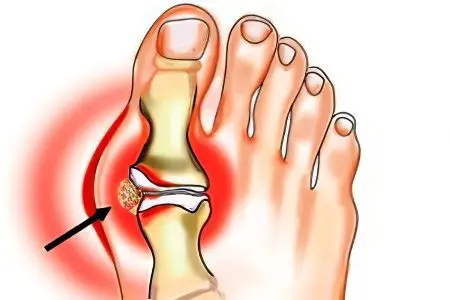
The causes of bumps on the legs are many other pathologies, among which are bursitis, exostoses, arthrosis of the metatarsophalangeal joints or, most characteristically, transverse flat feet. It has been noted that the development of hallux valgus is also influenced by genetic factors, disturbances in the work of the endocrine system and osteoporosis. It is noteworthy that improperly selected shoes can also do their owner a disservice.
The “risk group” includes, first of all, shoes with high heels and with a narrow toe: the load on the foot is distributed unevenly, as a result of which its anterior section is deformed and arthrosis of the big toe joint occurs. The causes of hallux valgus also include various injuries of the lower leg and foot, birth defects or the consequences of severe neuromuscular diseases (poliomyelitis, cerebral palsy).
Let us consider in more detail the main diseases leading to the development of bumps on the big toe.
Valgus deformity of the foot
Valgus deformity of the foot is a curvature of its axis, when the middle part of the foot goes down, the heel turns outwards, and its inner edge goes down. At the same time, the feet flatten, fall inward. Incorrect redistribution of the load on the foot leads to the fact that the big toe is displaced outward, and the metatarsophalangeal joint sticks out to the side. As the pathology progresses, the deformation will increase, as a result of which an outgrowth forms on the bone.
The following pathologies are capable of provoking valgus deformity of the foot with the formation of bumps:
Congenital dysplasia of the connective tissue.
Postponed bone fractures, torn ligaments.
Osteoporosis.
Diseases of the endocrine system, including diabetes mellitus.
Posture disorders.
Congenital anomalies of development with deformity of the foot. Such a pathology is not detected immediately, but as the child grows older, when he begins to walk, wear improperly selected shoes, and does not experience adequate physical exertion.
Patient has flat feet.
If a person with flat feet gains weight rapidly, as often happens with women during childbearing, the bumps on the toe will increase in size as the disease progresses.
Postponed paralysis and skeletal injury of the foot can lead to the appearance of bumps even in the case when the patient has not previously been diagnosed with flat feet.
The bumps on the legs will be the larger in size, the stronger the abduction of the rear and forefoot.
Gout
Gout is a rheumatic pathology that is accompanied by the deposition of crystals of uric acid salts in the joints, and after some time in the kidneys. With gout, bumps form in the area of uXNUMXbuXNUMXbthe thumb, which are called tophi and gouty nodules. They are an accumulation of salt crystals in soft tissues. In addition to the lower extremities, such bumps appear on the thighs, shins, and feet.
Tophi is not the only manifestation of the disease. The thumb in an acute attack of gout swells due to inflammation of its joints. This phenomenon is called gouty arthritis.
The reasons that can provoke the development of gout include:
Hereditary predisposition to disruption of metabolic processes in the body.
Overeating, inclusion in the menu of a large number of meat dishes.
Leading a sedentary lifestyle.
Kidney diseases.
Leukemia, lymphoma and polycythemia.
Psoriasis.
Treatment with cytostatics and some other drugs.
Alcohol abuse.
Most often, gout affects men over 40 years of age. Women get sick 20 times less than men.
Rheumatoid arthritis
Rheumatoid arthritis. In this disease, small joints are primarily affected, including the joints of the big toes. Bumps are formed due to severe inflammation of the articular tissues. Provoke the development of the disease can be such reasons as:
Immunological disorders.
Infections: transmitted rubella, cytomegalovirus infection, Epstein-Barr virus, etc.
The consequence of rheumatoid arthritis is the formation of joint contractures, their subluxations, chronic inflammation.
External causes
For example, wearing high-heeled shoes, getting a serious injury, etc. In this case, bumps on the big toes appear due to the fact that the load on the lower limbs is not distributed correctly, which leads to joint deformity, the appearance of calluses on bone tissues, as well as their growth.
It is extremely important to detect the emerging lump in time and consult a doctor, because the successful outcome of the treatment depends on it. Otherwise, pain will appear, an operation may be necessary, or the person will become lame.
Symptoms
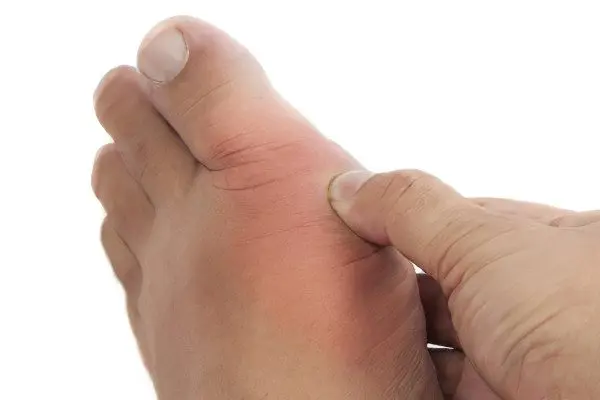
Bumps on the legs at the big toe appear with various diseases. They look like unnatural formations, towering above the joint of the thumb, or to the side of it. Bumps worsen the appearance of the limb, are a cosmetic defect, make a person experience psychological discomfort.
Depending on the underlying disease that provoked the appearance of bumps on the toes, the following symptoms are distinguished:
With hallux valgus deformity of the patient’s feet, pain is disturbed during walking and at rest, which are especially aggravated when wearing improperly selected shoes. It hurts not only the bump itself, but also the muscles of the lower leg. A person’s gait is noticeably disturbed. The patient rests on the floor with the entire surface of the foot. If the disorder is not treated, then hallux valgus will progress. Depending on the cause that provoked the appearance of bumps on the foot, the patient may have symptoms of diabetes, osteoporosis, thyroid disease, etc.
In an acute attack of gout, a person experiences sharp pains in the area of the metatarsophalangeal joint of the thumb, it swells strongly. The skin over the joint becomes red and shiny, hot to the touch.
With rheumatoid arthritis, the patient simultaneously inflames the joints of the fingers on both legs. In the morning, a person will experience stiffness in them. Bumps on the toes are a consequence of the accumulation of intra-articular exudate, their deformation due to the replacement of normal tissue of synovial bags with fibrous tissue. In the end, the patient will have a complete immobilization of the affected joints. In addition to the lower extremities, the hands are often affected.
Common symptoms of bumps on the big toe include:
Fatigue in the legs, which is especially noticeable towards the end of the working day.
It is difficult for a person with a bump on his foot to find shoes.
When wearing open and closed shoes, the patient will experience pain.
Calluses are more likely to appear on the toes and on the sole of the foot.
As the pathology progresses, the person will have difficulty wearing shoes that previously fit.
At an early stage in the development of pathology, the thumb only deviates slightly to the side, and the bump itself is completely invisible. Then it will begin to increase in size, a dry callus may form under the middle phalanx of the finger.
The third stage of the development of pathology is accompanied by a pronounced displacement of the thumb. In this case, its top will be turned to the inside of the foot. The bump becomes larger, the skin in the place of its localization undergoes excessive keratinization. If the deformity is not eliminated, this will lead to the fact that all other toes will begin to undergo pathological changes.
When is it necessary to see a doctor?
What are serious enough symptoms that require an immediate trip to the orthopedist? First of all, this is the formation of a bump in the area of the metatarsophalangeal joint. You should also pay attention to swelling and redness near the thumb (at its base). Thickening of the skin, the appearance of calluses or unpleasant painful sensations are also possible. A bump occurs when the metatarsal head becomes bulging and the big toe deviates outward. This area of the foot is squeezed by shoes, which causes inconvenience and pain.
Diagnostics
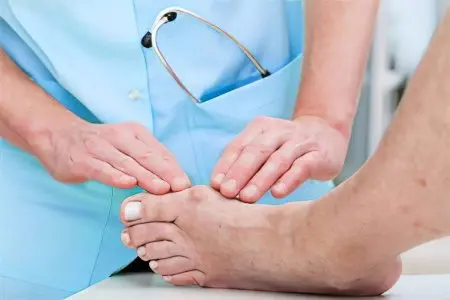
Diagnosis of bumps on the legs begins with an external examination of the patient, their palpation and listening to the patient’s main complaints. The doctor evaluates the structure of the patient’s foot, examines the ratio of the fingers relative to each other. It is important to track the features of a person’s gait, to clarify the nature of the shoes that he wears.
Without fail, the patient is referred to such diagnostic procedures as:
X-ray stop.
Plantography. This method allows you to detect flat feet by sole prints.
Blood donation for the detection of rheumatoid factor and antikeratin antibodies.
Blood donation for general and biochemical analysis.
MRI of the affected joint.
Puncture of the joint fluid with its further study.
Sometimes it is necessary to consult not only an orthopedist, but also a neurologist, neurosurgeon, endocrinologist, rheumatologist. Patients with gout will need to visit a urologist.
Treatment
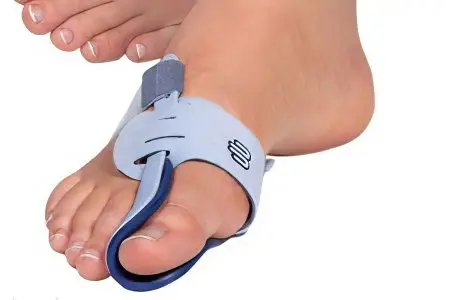
Treatment for bumps on the legs will depend on the cause that provoked their appearance.
Bumps on the big toes with hallux valgus
Modern medicine allows you to get rid of bumps on your legs with the help of surgery. There are about 200 types of surgical intervention. All of them are aimed at reducing the angle between the metatarsal bones. At the same time, it is possible to preserve not only the joint itself, but also its mobility.
At the initial stage of the formation of pathology, the problem can be dealt with by conservative methods. The patient is shown wearing bandages and insoles, which sometimes help restore the metatarsal bone to its correct shape. In addition, the insoles make it possible to prevent the further development of deformity, as well as to consolidate the result of the treatment.
The first stage of bumps on the leg with hallux valgus can be treated by the following methods:
Lose excess weight through diet and increased physical activity.
Physiotherapy methods: application of therapeutic mud, magnetotherapy, electrophoresis, paraffin therapy.
Physiotherapy exercises according to individually compiled complexes. These can range from simple exercises, such as fan-shaped spreading of fingers, squeezing and unclenching fingers, to complex exercises that are carried out together with a trainer.
A visit to the massage therapist’s office or self-massage. You can rotate your hands with your big toe in the phalanx clockwise, you can massage the muscles passing between the fingers, as well as the ligaments of the big toe and the muscles on the inside of the toe.
Use of corrective insoles and bandages. The insoles allow you to reduce the load on the forefoot, correctly redistribute the weight and give the foot a natural physiological position. Under the heel of the insole there is a special recess, under the arch of the foot there is an orthopedic arch support, and in its bow there are straps that allow you to correctly place your fingers in the shoe. The insoles have additional fixators and a metatarsal cushion. Bandages allow you to keep your finger in the correct position. They are worn at night, and the insoles, on the contrary, are used during the day.
Passing a course of shock wave therapy.
The use of drugs from the group of NSAIDs. In general, these drugs do not affect the development of the disease, but help to eliminate pain and relieve inflammation, which makes it easier for the patient to feel better.
Creams and ointments can relieve inflammation, increase blood circulation in the affected area and reduce pain, including: Turpentine ointment, shark oil ointment, Valgusteen gel, Stop Bump cream, etc.
Surgery
Severe deformity with large bumps requires surgical intervention.
Depending on the cause of the disease and the stage of its development, the following surgical procedures can be performed:
Removal of bumps using a laser.
Joint replacement with an implant.
Resection with arthroplasty.
Performing an osteotomy.
Performing arthrodesis of the talocalcaneal joint.
Tendon transplant or shortening.
Exostectomy, in which not only part of the head of the metatarsal bone is excised, but also the soft tissues located around it.
The Vreden-Mayo operation to remove the bones on the legs has a good cosmetic effect. In this case, in addition to the bump, the head of the 1st metatarsal bone will be cut down. However, most of the supporting bone will be removed from the patient, which can cause a recurrence of the disorder.
Minimally invasive techniques, in which the incision does not exceed 3 mm, allow the patient to recover quickly, since the doctor performs all manipulations through small punctures. The operation is carried out under the control of the x-ray machine. However, such procedures are applicable only with a slight deformity of the thumb.
With the help of a laser, the doctor has the ability to cut tissue in thin layers, so the mobility of the joints is preserved. In addition, such an operation can reduce the rehabilitation time and prevent the development of bleeding and infection of the wound. The bump on the toe is also polished using a laser until it is level with the lateral surface of the foot. Laser treatment can be combined with osteotomy or arthroplasty.
As it becomes clear, there are many operations to remove bumps on the legs of the big toe, but their main stages differ little. The doctor makes an incision on the inside of the phalanx of the first toe, dissects its capsule, excised the bump itself, cuts the first metatarsal bone and moves its fragments, giving them the correct position. Screws or staples are used to fix the bone. Then the doctor sews up the dissected capsule and the incision itself, applying a sterile bandage on top.
In the future, the patient is required to wear either a cast or a fixing bandage. The load from the foot during the rehabilitation period should be minimized as much as possible.
The operation may not be performed for all patients. Contraindications to its implementation: severe cardiovascular pathologies, thrombosis, blood clotting disorders, diabetes mellitus, diseases of the musculoskeletal system and some other pathologies.
Bumps for gout
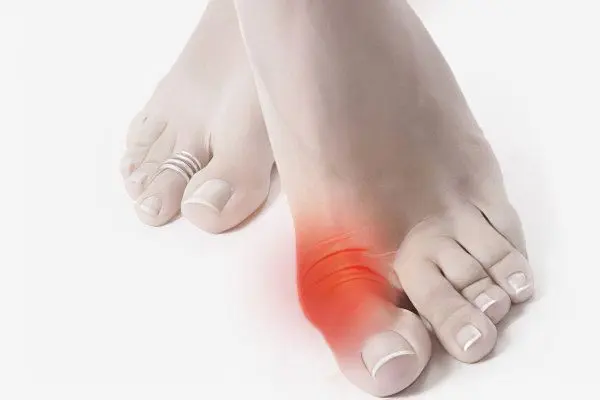
Treatment of gout is based on controlling the level of uric acid in the body, for which it is necessary to reduce its production. To do this, the patient is prescribed a diet with the rejection of meat and fish dishes, vegetables, mushrooms, caviar. Be sure to limit your salt intake. The patient should drink at least 3 liters of water per day.
To stop pain and relieve inflammation, patients are shown taking Indomethacin and Colchicine. Anti-inflammatory ointments and gels are applied to the affected finger. Drugs are prescribed for the speedy withdrawal of uric acid.
If a large amount of intra-articular effusion occurs, then a puncture is performed with its evacuation. Perhaps intra-articular administration of hormonal drugs, for example, Prednisolone. The sooner treatment is started, the better the prognosis.
Bumps in rheumatoid arthritis
To cope with bumps on the legs with rheumatoid arthritis, the patient is prescribed drugs from the NSAID group. To reduce the rate of destruction of the articular tissue will allow such means.
Patients with rheumatoid arthritis are advised to visit the pool, go swimming, and perform exercise therapy.
Surgical methods of treatment include arthroscopy and joint arthroplasty. They are used in the case when the articular structures are no longer subject to restoration or are severely destroyed.
If 1-2 joints become inflamed at the same time, and the process itself is not too intense, then the prognosis for recovery is favorable. With polyarthritis, it worsens.
Video: Dr. Evdokimenko “How to treat a bone on the big toe – personal experience. Is it gout? Do I need to do an operation. ”:









